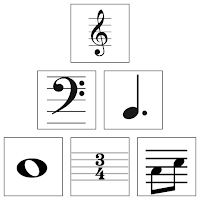Building Blocks: Building Major Scales II
If this is your first time here I recommend going here first. In the last lesson, we learned how to build major scales by adding one step at a time from the major scale pattern (WWHWWWH). Since you should have a decent understanding of how major scales are constructed by now, I'll just get right into it.
This is another method of finding major scales. This time let's find the D Major scale. We should already know that the first note is going to be D, so for the first step let's write out the letters from D to D:
D E F G A B C D
Now let's mark where the half-steps are. I will use the symbol "^" to mark the half-steps. Remember that in the musical alphabet there are half-steps between the notes B and C, and also between E and F, so it will look like this:
D E^F G A B^C D
We need to figure out whether this is a D Major scale or not. Remember that it needs to follow the major scale pattern, which has half steps between the 3rd and 4th notes, and between the 7th and 8th notes. We can see here that the half-steps are not in the correct places in order for this to be a major scale.
The distance between D and E is already a whole-step, so there's no problem there. Next, we need to look at the distance between E and F, the 2nd and 3rd notes in our scale here. Remember that according to the major scale pattern the distance between the 2nd and 3rd notes in a major scale need to be a whole-step apart. E to F is only a half-step, so we need to increase that distance to a whole-step. We could add a flat to the E, and that would make it Eb to F which is a whole-step, but then that would change the distance between the first two notes. We already determined that the first two notes were correct so we don't want to do that. Instead we will add a sharp to the F, raising it to F#. Now we have E to F# which is indeed a whole-step. So now we have:
D E F# G A B C D
and marking the half-steps:
D E F#^G A B^C D
Raising the F to F# not only gave us a whole-step between the 2nd and 3rd notes, but it also changed the distance between the 3rd and 4th notes from a whole-step to a half-step. The major scale pattern tells us we need a half-step between the 3rd and 4th notes, so that worked out pretty well for us. Now we can see the only thing wrong with this scale is that the other half-step is not between the 7th and 8th notes.
The other half-step is currently between B and C, the 6th and 7th notes. The major scale pattern tells us this needs to be a whole-step, so let's do the same thing we did to move the other half-step in the scale. We'll add a sharp to the C, making it C#. Now we have B to C#, which is a whole-step. In doing that, we also changed the distance between the 7th and 8th notes from a whole-step to a half-step, which is exactly what we needed! Now we have:
D E F#^G A B C#^D
So is this a D Major scale? Well the half-steps are now between the 3rd and 4th notes, and between the 7th and 8th notes, which according to the major scale pattern (WWHWWWH) is correct. So this is definitely a D Major scale!
If you have any questions, post them in the comments below!

Comments
Post a Comment
Feel free to ask questions or start a discussion, or leave a suggestion for future articles! Please keep it civil.